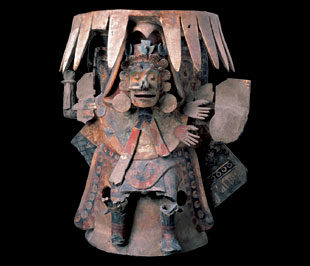|
























|
|









Gods and Rituals
The religious universe in the Aztec empire was highly complex, and each people recognized one basic creator deity. The patron god of the Aztecs was Huitzilopochtli, who guided them to the site of Mexico-Tenochtitlan, the place from which they would dominate the universe. They imagined him to be the solar warrior par excellence.
Also important was Tezcatlipoca, ancestral divinity of nocturnal war and patron of virility. His brother Quetzalcoatl, the god of civilization and patron of the wind, was venerated by numerous Mesoamerican peoples. Earth's various attributes were deified: for example, Coatlicue embodied the origin of life; Tlaltecuhtli embodied the final destination of man; and Chicomecoatl embodied the sphere in which food was created.
All Mesoamerican peoples based their economy on the intensive cultivation of maize, chili, squash, and beans; thus Tlaloc and his companion Chalchiuhtlicue, the gods of rain and water respectively, played a crucial role in indigenous religion. The deities Xochipilli and Xipe Totec, who patronized the renewal of nature with the arrival of the rains, were linked with human maturity, the art of silverwork, and war.
Just as Mesoamerican religion is characterized by its complexity, there was a great variety of rites and ceremonies, differentiated in accordance with the worship of each deity. One such rite was the well-known extraction of the heart in which the sacrificial knife was used. Related sacred objects were the techcatl, the altar table where this practice was carried out, and the cuauhxicalli, a receptacle that contained the human hearts and their blood, the sacred food.
Deified warrior brazier. Aztec, ca. 1500. Fired clay and pigment, 91 x 76 x 57.5 cm. Museo Nacional del Virreinato, INAH, Tepotzotlán. Photo Michel Zabé, assistant Enrique Macías.
|
|